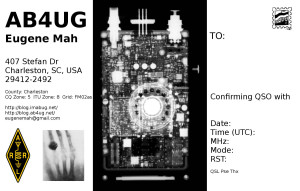This is an article about the #WATwitter Thanksgiving QSO party that I was asked to write for DXCoffee. You can see the original post here.
Twitter is one of many social media sites that helps connect people around the globe by letting people send short 140 character messages. As it turns out, there are a great many amateur radio operators around the world who also use Twitter. Some of them use their call signs as their Twitter ID, or might use something else. How do you find Twitter-using amateur radio operators? Try searching for a call sign, or look at the #hamr or #hamradio hash tags.
The idea for the Worked All Twitter Thanksgiving QSO Party started in 2011 when Connie Bird/NR4CB (@Bionic_Nerd on Twitter) came up with the #WATwitter hash tag to help arrange QSOs with other Twitter-using amateur radio operators over Thanksgiving. That grew into Twitter hams trying to work other Twitter hams. Like the Worked All States or Worked All Continents, the idea behind Worked All Twitter (WATwitter) is to make contacts with as many Twitter-using amateur radio operators as you can.
In September 2012, the idea of making Thanksgiving WATwitter a regular annual event was proposed. In the US, Thanksgiving is perhaps the largest holiday of the year involving mass migrations of people traveling to visit family. Many people are off work or school and close to their radios, which makes it easier to make contacts.
WATwitter Guidelines
This year the WATwitter Thanksgiving QSO party will take place between November 21-25, 2012. These are some guidelines proposed by Connie/NR4CB for the WATwitter Thanksgiving QSO Party
Who: Any licensed operator who also uses Twitter
Where: All bands, all modes. To let as many people as possible participate, use the portion of the band open to the most people, i.e. the technician portion of 10m, the general class portion of 20m, etc
Exchange: Your normal exchange plus your Twitter handle, especially if it’s not your call sign
Spotting: Self-spotting is practically required. Tweet your frequency, interact with people on Twitter, and get other people to meet you on the air at a specific time and frequency.
Hashtags: #WATwitter and either #hamr or #hamradio
Why: Connect with people using both social media and on the air
Have fun! Log your contacts, tweet your tallies to others, but there are no scores or awards. A nice twitter app created by Tomas/OK4BX (@ok4bx) will keep track of the activity during the event. Include@twQSO in all the QSOs you tweet.
WATwitter doesn’t have to happen at Thanksgiving though. It can happen at any time. If you’re on the air, throw your CQ out onto Twitter (using the #WATwitter and #hamr/#hamradio hash tags) and see who responds.
